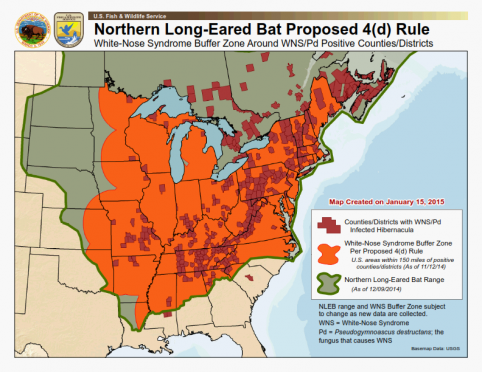The U.S. Fish and Wildlife Service (FWS) announced the northern long-eared bat is now classified as a threatened species under the Endangered Species Act (ESA). This new designation allows the FWS to create regulations that protect the animal from becoming endangered or extinct. The bat was added to the threatened species list because its populations were being “devastated” by a fungal disease called white-nose syndrome.
There has been concern that this new ruling will have adverse effects on the energy industry throughout the eastern United States, where the bat calls home. According to the FWS, the species range includes 37 states from Maine to North Carolina on the Atlantic Coast, westward to eastern Oklahoma and north through the Dakotas, reaching into eastern Montana and Wyoming.

If species gains the U.S. Fish and Wildlife’s recommended “endangered” designation in April, shale, wind energy developers could be affected.
Under the ESA, the FWS may implement special rules under section 4(d) for wildlife listed as threatened. Such rules enable the Service to tailor protections of the ESA to those that are “necessary and advisable to provide for the conservation of such species.” They also enable prohibitions that do not further the conservation of the species to be relaxed, reducing the regulatory burden on the public, according to the release from the Wildlife Service.
“Bats are a critical component of our nation’s ecology and economy, maintaining a fragile insect predator-prey balance; we lose them at our peril,” said Service Director Dan Ashe.
For areas of the country affected by white-nose syndrome, the measures provided in the interim 4(d) rule exempt “take” (a term under the ESA that includes harming, harassing or killing a listed species) resulting from certain activities. These activities include forest management practices, maintenance and limited expansion of transportation and utility rights-of-way, removal of trees and brush to maintain prairie habitat, and limited tree-removal projects, provided these activities protect known maternity roosts and hibernation caves. The interim 4(d) rule also exempts take resulting from removal of hazardous trees, removal of northern long-eared bats from human dwellings, and research-related activities.
The special rule from the FWS is designed to reduce any undue burden on the public, but the energy industry may still feel the effects of this decision. “Even the special take rule, as currently proposed, would do little to blunt the impact of the threatened listing on the bulk of the energy industry,” says Benjamin Cowan and Andrew Davitt of Locke Lord LLP.
The threatened species listing becomes effective on May 4, 2015, 30 days after publication of the final listing determination in the Federal Register.
IPAA Unhappy with the ruling
“From day one, the U.S. Fish and Wildlife Service acknowledged that the greatest threat to the [bat] is a fungal disease,” said Dan Naatz, Senior Vice President of Government Relations and Political Affairs for the Independent Petroleum Association of America (IPAA). “This is the agency’s most restrictive designation to date – potentially affecting a myriad of U.S. industries … in regions where the bat habitat exists.
Mr. Naatz said independent oil and natural gas producers are good stewards of the land they operate on and this new restriction will not cure the fungal disease responsible for damaging the bat population. According to Naatz, “Energy production and species conservation can go hand in hand, but not under the current regulatory framework outlined under the ESA.”
Important disclosures: The information provided herein is believed to be reliable; however, EnerCom, Inc. makes no representation or warranty as to its completeness or accuracy. EnerCom’s conclusions are based upon information gathered from sources deemed to be reliable. This note is not intended as an offer or solicitation for the purchase or sale of any security or financial instrument of any company mentioned in this note. This note was prepared for general circulation and does not provide investment recommendations specific to individual investors. All readers of the note must make their own investment decisions based upon their specific investment objectives and financial situation utilizing their own financial advisors as they deem necessary. Investors should consider a company’s entire financial and operational structure in making any investment decisions. Past performance of any company discussed in this note should not be taken as an indication or guarantee of future results. EnerCom is a multi-disciplined management consulting services firm that regularly intends to seek business, or currently may be undertaking business, with companies covered on Oil & Gas 360®, and thereby seeks to receive compensation from these companies for its services. In addition, EnerCom, or its principals or employees, may have an economic interest in any of these companies. As a result, readers of EnerCom’s Oil & Gas 360® should be aware that the firm may have a conflict of interest that could affect the objectivity of this note. The company or companies covered in this note did not review the note prior to publication. EnerCom, or its principals or employees, may have an economic interest in any of the companies covered in this report or on Oil & Gas 360®. As a result, readers of EnerCom’s reports or Oil & Gas 360® should be aware that the firm may have a conflict of interest that could affect the objectivity of this report.

